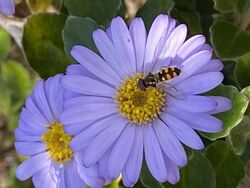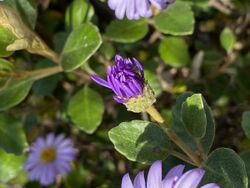Biology:Olearia tomentosa
| Olearia tomentosa | |
|---|---|

| |
| Scientific classification | |
| Kingdom: | Plantae |
| Clade: | Tracheophytes |
| Clade: | Angiosperms |
| Clade: | Eudicots |
| Clade: | Asterids |
| Order: | Asterales |
| Family: | Asteraceae |
| Genus: | Olearia |
| Species: | O. tomentosa
|
| Binomial name | |
| Olearia tomentosa | |
| Synonyms[1] | |
|
List
| |


Olearia tomentosa, commonly known as the toothed daisy-bush,[2] is a species of flowering plant in the family Asteraceae and is endemic to south-eastern continental Australia. It is a spreading shrub with egg-shaped leaves, the edges toothed or lobed, and blue or white and yellow, daisy-like inflorescences.
Description
Olearia tomentosa is a spreading shrub that typically grows to a height of up to about 2 m (6 ft 7 in) and has its branchlets densely covered with rust-coloured hairs. The leaves are arranged alternately along the stems, egg-shaped, 10–85 mm (0.39–3.35 in) long, 9–50 mm (0.35–1.97 in) wide on a petiole up to 15 mm (0.59 in) long. The edges of the leaves are toothed of lobed, the lower surface densely hairy. The heads or daisy-like "flowers" are arranged singly or in small groups on a peduncle up to 70 mm (2.8 in) long, each head 25–59 mm (0.98–2.32 in) in diameter with a bell-shaped involucre 7–10 mm (0.28–0.39 in) long at the base. Each head has 12 to 33 white or blue ray florets, the ligule 12–25 mm (0.47–0.98 in) long, surrounding 30 to 90 yellow disc florets. Flowering mainly occurs from September to December and the fruit is a ribbed achene about 4 mm (0.16 in) long, the pappus 7–9 mm (0.28–0.35 in) long.[2][3]
Taxonomy
This daisy was described in 1798 by German botanist Johann Christoph Wendland who gave it the name Aster tomentosus.[4][5] In 1836, Augustin Pyramus de Candolle changed the name to Olearia tomentosa.[6] The specific epithet (tomentosa) means "covered with matted hairs", referring to the underside of the leaves.[7] It is the type species of the genus, and was placed in the section Dicerotriche, yet genetically is sister to the section Asterotriche.[8]
Distribution and habitat
Toothed daisy-bush is found south of the Hastings River and inland as far as the Blue Mountains in eastern New South Wales, and east of Mallacoota Inlet in the far east of Victoria.[2][3] It grows on sandstone-based soils in dry sclerophyll forest and heath.[9]
Ecology
Olearia tomentosa plants are generally killed by bushfire, though there are reports of plants regrowing from suckers after fire.[9]
Use in horticulture
Not commonly seen in cultivation, O. tomentosa grows in soil with good drainage in a sunny or part-shaded location. Regular pruning prevents the plant from becoming leggy,[7] and can rejuvenate older plants. The species is moderately frost-hardy.[10]
References
- ↑ 1.0 1.1 "Olearia tomentosa". Australian Plant Census. https://biodiversity.org.au/nsl/services/apc-format/display/106981.
- ↑ 2.0 2.1 2.2 Lander, Nicholas S.. "Olearia tomentosa". Royal Botanic Garden Sydney. https://plantnet.rbgsyd.nsw.gov.au/cgi-bin/NSWfl.pl?page=nswfl&lvl=sp&name=Olearia~tomentosa.
- ↑ 3.0 3.1 Walsh, Neville G.; Lander, Nicholas S.. "Olearia tomentosa". Royal Botanic Gardens Victoria. https://vicflora.rbg.vic.gov.au/flora/taxon/dcb227a0-5459-4d14-8554-d25ae8a963ed.
- ↑ "Aster tomentosus". https://biodiversity.org.au/nsl/services/rest/name/apni/538278/api/apni-format. Retrieved 23 August 2022.
- ↑ Wendland, Johann C. (1798). Sertum Hannoveranum. Hannover. p. 8. https://bibdigital.rjb.csic.es/viewer/12934/?offset=#page=8&viewer=picture&o=bookmark&n=0&q=. Retrieved 23 August 2022.
- ↑ "Olearia tomentosa". https://biodiversity.org.au/nsl/services/rest/name/apni/537206/api/apni-format. Retrieved 23 August 2022.
- ↑ 7.0 7.1 Walters, Brian. "Olearia tomentosa". Plant Guide. Australian Native Plants Society (Australia). https://anpsa.org.au/plant_profiles/olearia-tomentosa/.
- ↑ Cross, E.W.; Quinn, C.J.; Wagstaff, S.J. (2002). "Molecular evidence for the polyphyly of Olearia (Astereae: Asteraceae)". Plant Systematics and Evolution 235 (1–4): 99–120. doi:10.1007/s00606-002-0198-9.
- ↑ 9.0 9.1 Benson, Doug; McDougall, Lyn (1994). "Ecology of Sydney Plant Species Part 2: Dicotyledon families Asteraceae to Buddlejaceae". Cunninghamia 3 (4): 789–1004 [903–04]. ISSN 0727-9620. https://www.rbgsyd.nsw.gov.au/getmedia/d2fb74b7-511c-4e1a-879a-850c01f74023/Volume-3(4)-1994-Benson_2i-789-1004.pdf.aspx. Retrieved 23 August 2022.
- ↑ Elliot, Rodger W.; Jones, David L.; Blake, Trevor (1997). Encyclopaedia of Australian Plants Suitable for Cultivation. 7: N–Po. Port Melbourne, Victoria: Lothian Press. p. 98. ISBN 0-85091-634-8.
Wikidata ☰ Q7086014 entry
 |

